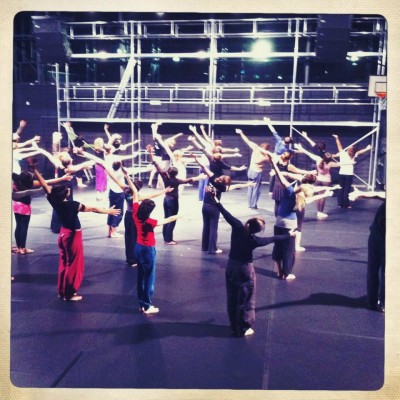One of the unexpected pleasures of my residency in Chicago before Christmas was a conversation with Bonnie Brooks who was Chair of the Dance Department at Columbia College (and before that President and Executive Director of Dance/USA). She is currently on sabbatical from Columbia and in that time has been traveling with the Legacy Tour of the Merce Cunningham Dance Company. She has been asked to document and evaluate the Tour and so has an extraordinarily rich insight into the final year of the company, an insight built upon a long association with MCDC and friendship with Cunningham. I’d intended to talk to her about Tabernacle and my work, but hearing her talk about Cunningham was much more interesting. Besides the more she talked about what mattered in Cunningham’s work, the more I recognised what values I share with it. I write this making no claim to ceaseless innovation of Cunningham’s work but simply a recognition of influence in what might look like very different work.

I was reminded of this reading David Velasco’s review of the final MCDC performances. He describes the necessity for him as a spectator to make choices, to acknowledge his own participation in making the performances. He enters in the work rather than simply observing it.
I have described Tabernacle as another Bodies and Buildings piece since I imagine it as a kind of structure (originally the tent where the Israelites encountered God, or for Catholics the small box that contains the consecrated host). The choreography creates a space but the work depends on people – performers and audiences – to enter in to that space. It offers a possibility but I understand that for some that possibility feels like a challenge.
Velasco writes in his review:
It was impossible to take in. I’m not the first to note the challenge of trying to see Cunningham choreography. The dances themselves are built to kill lazy looking: You have to make decisions. The Events, particularly those with multiple stages (an invention of the past decade), amplify this effect. This wasn’t theater-in-the-round; it was theater-in-the-surround.
Seeing and moving were simultaneous. (Even when you were standing still you were deciding to stand still; you might as well have been moving.) This made you, to some small extent, like the dancers, but also made you all the more alert to the scission between dancer and audience. To different kinds of seeing and moving. To different relationships between seeing and apprehending. Theirs and yours. Yours and everyone else’s.
Over and over again there was the question: How should you see? Should you turn on your eidetic memory, so as to “return” to it later, or turn off your camera-eye and lose yourself in the mix? Should you stand in one place and let it unfold in a single grand, cinematic sweep? Do you sweep the floors hunting for the “best” bits? What are the “best” bits? What do we do with this seeing? “That is the crucial transition, from seeing to entering,” Jill Johnston wrote in a review of the debut of Cunningham’s Aeon fifty years ago—which at least had a nice ring to it, a useful koan. The urgency of these questions about experience became a frame for the experience; that movement of “entering” was also an exiting. Every looking-decision was a goodbye to other possibilities, a million minigoodbyes to set you up for the big one.
After fifty minutes, the fourteen dancers, all dancing across the platforms, simply walked off those black Marley stages with the same quiet authority with which they’d mounted them. The lights and music quit, and that was it.
“Well, so what do you do after you’ve witnessed the end of modern dance?” a friend asked, without a trace of irony. Someone raised a glass. And suddenly it was a new year.




Post a Comment